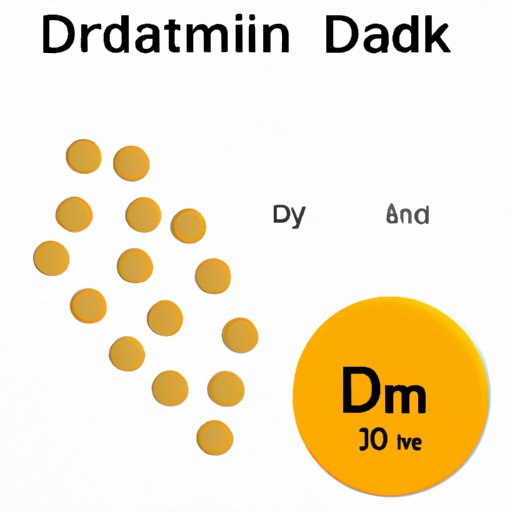
I. Introduction
As we grow older, we’ve always heard the importance of certain vitamins and nutrients for our health. Vitamin D has been one such vitamin that we might have come across several times. However, not everyone knows what it is, how it works, how much should we consume, and whether it is fat-soluble or water-soluble. This article seeks to explore the importance of vitamin D, its sources, the benefits and risks of taking vitamin D supplements, how it affects human health, and most importantly, whether it is fat-soluble or not.
II. How Fat-Soluble Vitamins Work in the Body
Fat-soluble vitamins are a group of organic compounds that dissolve in fat and oils, rather than water. The term “fat-soluble” means that the vitamins can be stored in the body’s fatty tissues, liver, and other organs. These vitamins include vitamins A, D, E, and K, and contribute to several biological functions like maintaining healthy skin, developing red blood cells, and making collagen. Unlike water-soluble vitamins, fat-soluble vitamins cannot be easily excreted from the body through urine.
III. What Vitamin D is and Its Importance to Human Health
Vitamin D is a fat-soluble vitamin that is essential for maintaining healthy bones, muscles, and teeth. Vitamin D is produced by the skin when exposed to sunlight and can also be consumed from certain foods and supplements. Vitamin D helps the body to absorb and use calcium and phosphorus which helps in strengthening the bones and muscles. It also helps to maintain a healthy immune system, improve brain function and reduce the risk of chronic diseases like cancer, diabetes, and heart diseases.
IV. Where Vitamin D Comes From and How It Is Metabolized in the Body
Vitamin D comes from a variety of sources, including sunlight, dietary supplements, and certain foods like fatty fish, egg yolk, cheese, and orange juice. When our skin is exposed to sunlight, it converts 7-dehydrocholesterol to vitamin D3, which is then transported to the liver and kidneys where it is metabolized into an active form of vitamin D3 or 1,25-dihydroxyvitamin D3. This active form of vitamin D3 regulates the body’s calcium and phosphorus levels and helps in strengthening the bones and muscles.
V. Benefits and Risks of Taking Vitamin D Supplements
Vitamin D supplements are used to maintain adequate levels of vitamin D in the body, especially when the body is not receiving enough from sunlight or diet. Benefits of taking vitamin D supplements include improved bone and muscle health, reduced risk of diabetes, cancer, heart diseases, and a healthy immune system. However, overconsumption of vitamin D supplements can lead to toxicity and adverse side effects like nausea, vomiting, kidney damage, and calcium buildup in the blood. The recommended daily intake of vitamin D for adults is 600-800 IU per day, while it is 400-1000 IU per day for children and infants.
VI. Comparison of Absorption and Utilization of Fat-Soluble Vitamins to Water-Soluble Vitamins
The key difference between fat-soluble and water-soluble vitamins is their solubility in water. Water-soluble vitamins dissolve in water and can be easily excreted by the body through urine if consumed in excess. Fat-soluble vitamins, on the other hand, dissolve in fats and oils and are stored in the body’s fatty tissues, liver, and other organs. As a result, the absorption and utilization of fat-soluble vitamins are slower and needed in smaller amounts, while water-soluble vitamins are absorbed quickly and needed in larger amounts.
VII. Role of Vitamin D in Bone Growth and Development
Vitamin D plays a crucial role in bone growth and development, especially in children and adolescents. It helps absorb calcium and phosphorus from the food we eat and helps strengthen bones and muscles. Vitamin D deficiency can lead to rickets in children, a condition that causes weak and deformed bones, and leads to soft bones, muscle weakness, and increased risk of fractures. In adults, vitamin D deficiency can cause osteomalacia, a condition that weakens the bones and muscles, leading to bone pain, muscle weakness, and an increased risk of fractures. To prevent vitamin D deficiency, it is recommended to consume vitamin D-rich foods or supplements, get regular sunlight exposure, and consult a physician before taking any supplements.
VIII. Conclusion
Vitamin D is an essential nutrient that plays a vital role in maintaining bone and muscle health, supporting a healthy immune system, and reducing the risk of chronic diseases. It is a unique vitamin that is not only produced by the body but also obtained through sunlight and diet. While it is essential for human health, overconsumption of vitamin D supplements can lead to toxicity and adverse side effects. Therefore, it is important to maintain sufficient levels of vitamin D in the body through a balanced diet, sunlight exposure, and supplements only if recommended by a medical professional.
Call to Action: Start adding vitamin D rich foods sources like fatty fish, egg yolks, and cheese into your diet and make sure to get enough sunlight exposure to keep your vitamin D levels in check.




